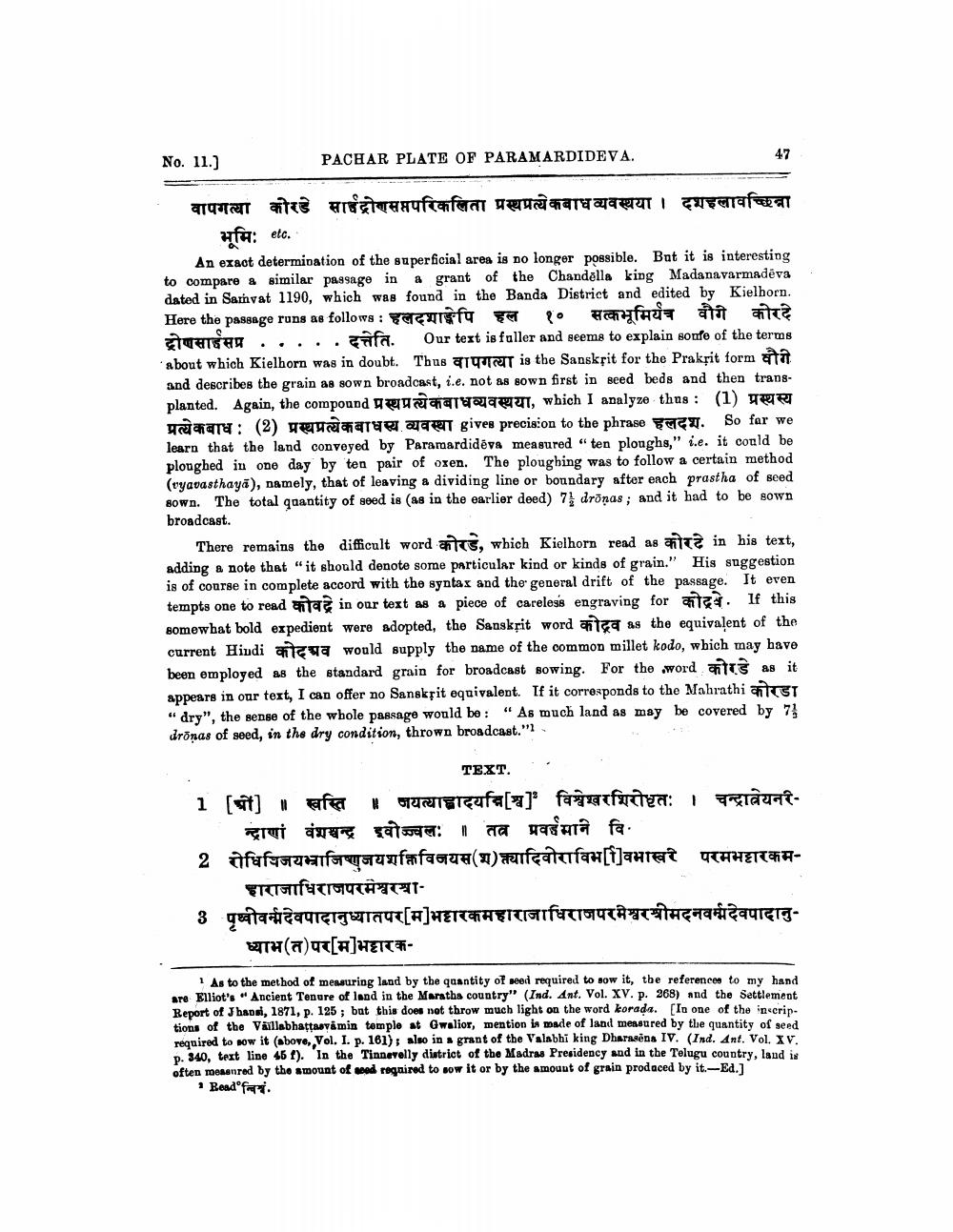________________
No. 11.)
PACHAR PLATE OF PARAMARDIDEVA.
वापगत्वा कोरडे साईद्रोणसप्तपरिकलिता प्रस्थप्रत्येकबाधव्यवस्थया । दशहलावच्छिन्ना
fa: etc.
An exact determination of the superficial area is no longer possible. But it is interesting to compare a similar passage in a grant of the Chandella king Madanavarmadeva dated in Samvat 1190, which was found in the Banda District and edited by Kielborn. Here the passage runs as follows: cafu po fHuy atat pe
THIGH ..... ifa. Our text is fuller and seems to explain some of the terms about which Kielhorn was in doubt. Thus alguer is the Sanskrit for the Prakrit forma and describes the grain as sown broadcast, i.e. not as sown first in seed beds and then transplanted. Again, the compound ge v aar , which I analyze thus : (1) Tee प्रत्येकबाध: (2) प्रस्थप्रत्येकबाधस्य व्यवस्था gives precision to the phrase हलदश. So far we learn that the land conveyed by Paramardidēva measured "ten ploughs," i.e. it could be ploughed in one day by ten pair of oxen. The ploughing was to follow a certain method (vyavasthayā), namely, that of leaving a dividing line or boundary after each prastha of seed sown. The total quantity of seed is (as in the earlier deed) 7 dronas; and it had to be sown broadcast.
There remains the difficult word atte, which Kielhorn read as att? in his text, adding a note that "it should denote some particular kind or kinds of grain." His suggestion is of course in complete accord with the syntax and the general drift of the passage. It even tempts one to read as in our text as a piece of careless engraving for it . If this somewhat bold expedient were adopted, the Sanskrit word #152 as the equivalent of the current Hindi H ua would supply the name of the common millet kodo, which may have been employed as the standard grain for broadcast sowing. For the word a s as it appears in our text, I can offer no Sanskrit equivalent. If it corresponds to the Mahrathi atet "dry", the sense of the whole passage would be : "As much land as may be covered by 7 dronas of seed, in the dry condition, thrown broadcast."
TEXT.
-
1 [at] afa
stefa[] favtatea: 1 Trauzeन्द्राणां वंशश्चन्द्र इवोज्ज्वलः । तत्र प्रवईमाने वि. 2 रोधिषिजयभ्राजिष्णजयशक्तिविजयस(श)त्यादिवोराविभ[1]वभावरे परमभट्टारकम
ERITYTOUCHIT3 पृथ्वीवर्मदेवपादानुध्यातपर[म]भट्टारकमहाराजाधिराजपरमेश्वरश्रीमदनवर्मदेवपादानु
TH(a)T[A]HETT
As to the method of measuring land by the quantity of weed required to sow it, the reference to my hand are Elliot's "Ancient Tenure of land in the Maraths country" (Ind. Ant. Vol. XV. p. 368) and the Settlement Report of Jhapa, 1871, p. 125; but this does not throw much light on the word korada. (In one of the inscriptions of the Vallabhattasvimin temple at Gwalior, mention is made of land measured by the quantity of seed required to sow it (above, Vol. I. p. 161) also in a grant of the Valabhi king Dharasēns IV. (Ind. Ant. Vol. XV. p. 340. text line 46 t). In the Tinn velly district of the Madru Presidency and in the Telugu country, land is often maanred by the amount of weed regaired to sow it or by the amount of grain prodaced by it.-Ed.]
* Read




